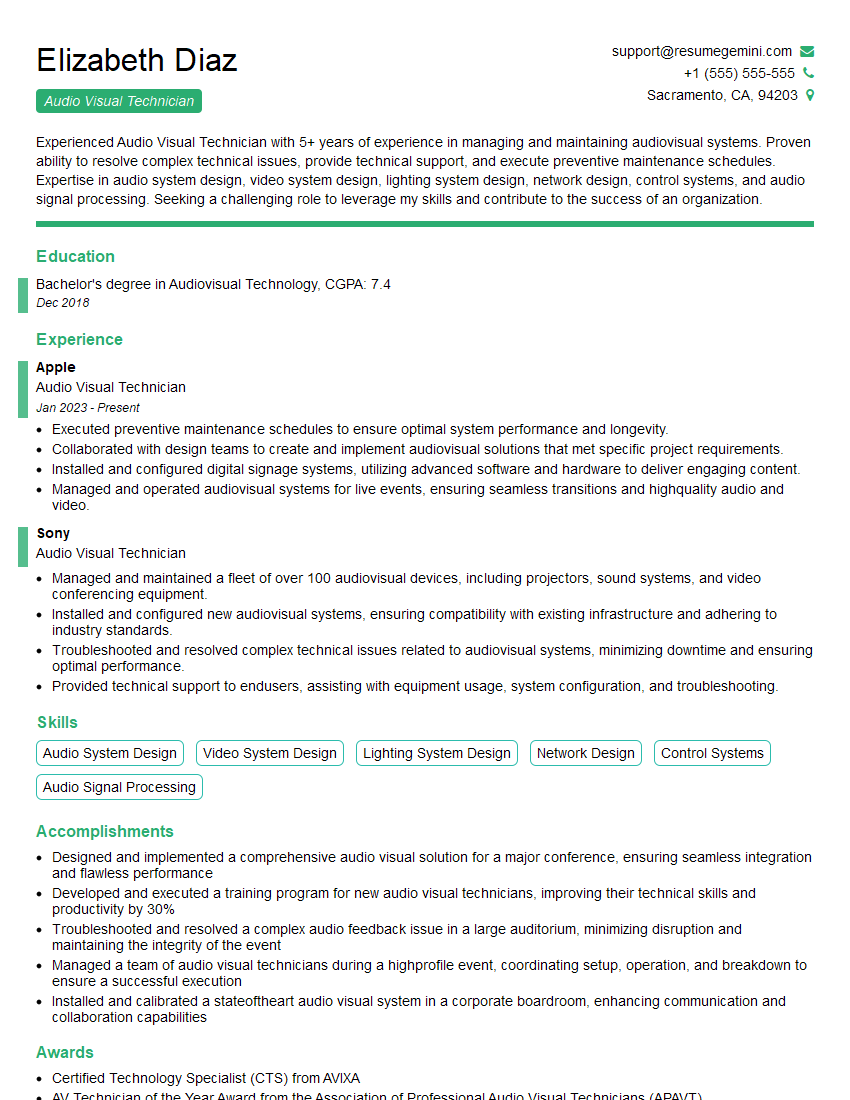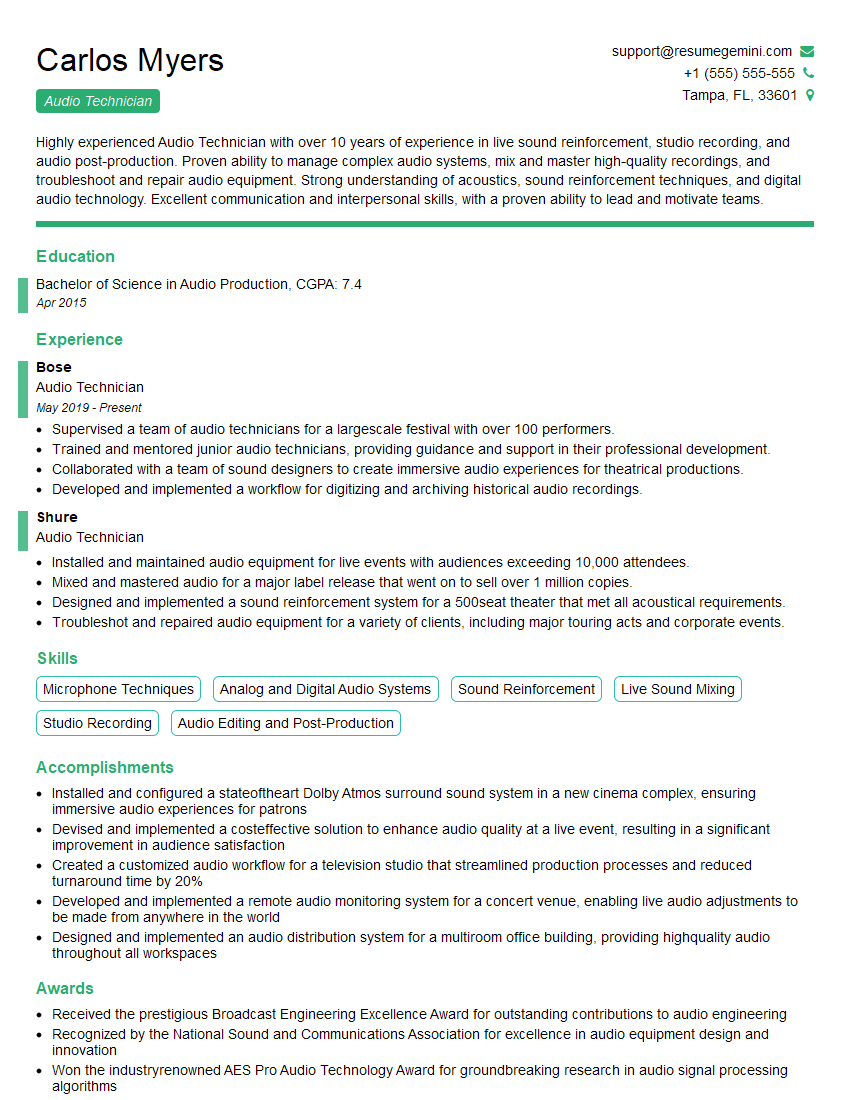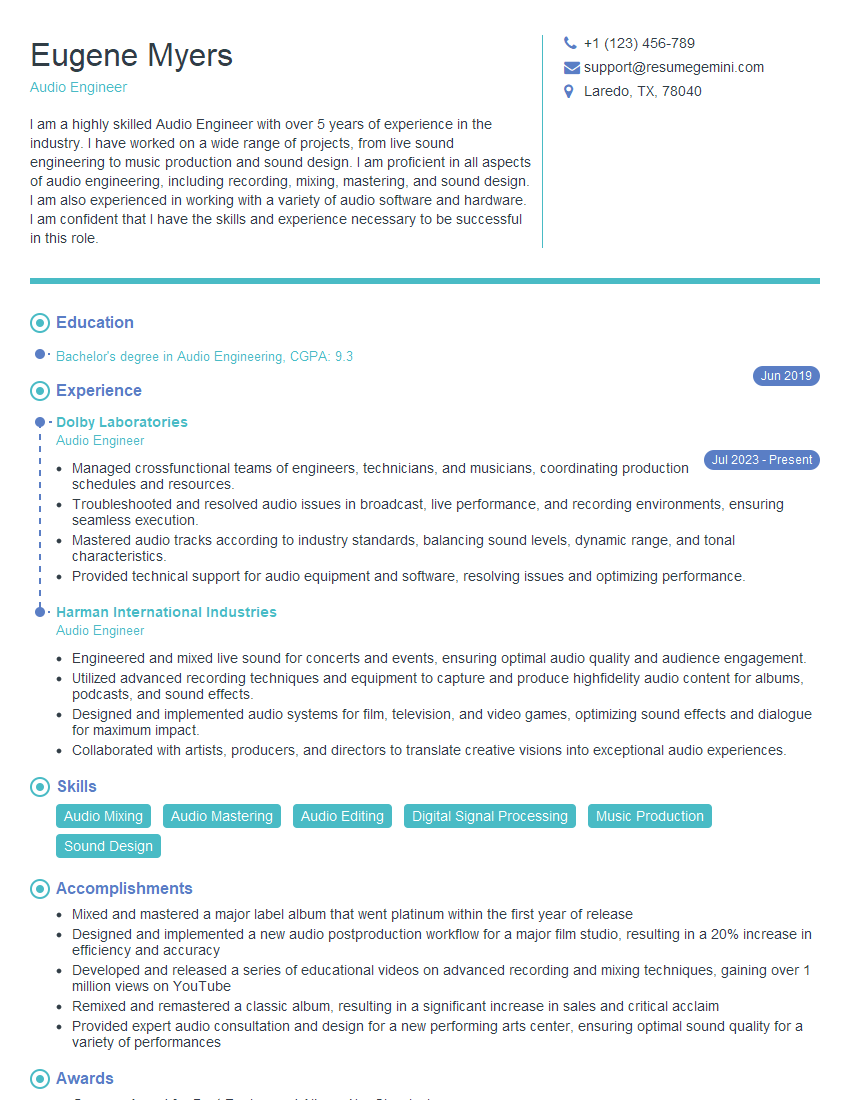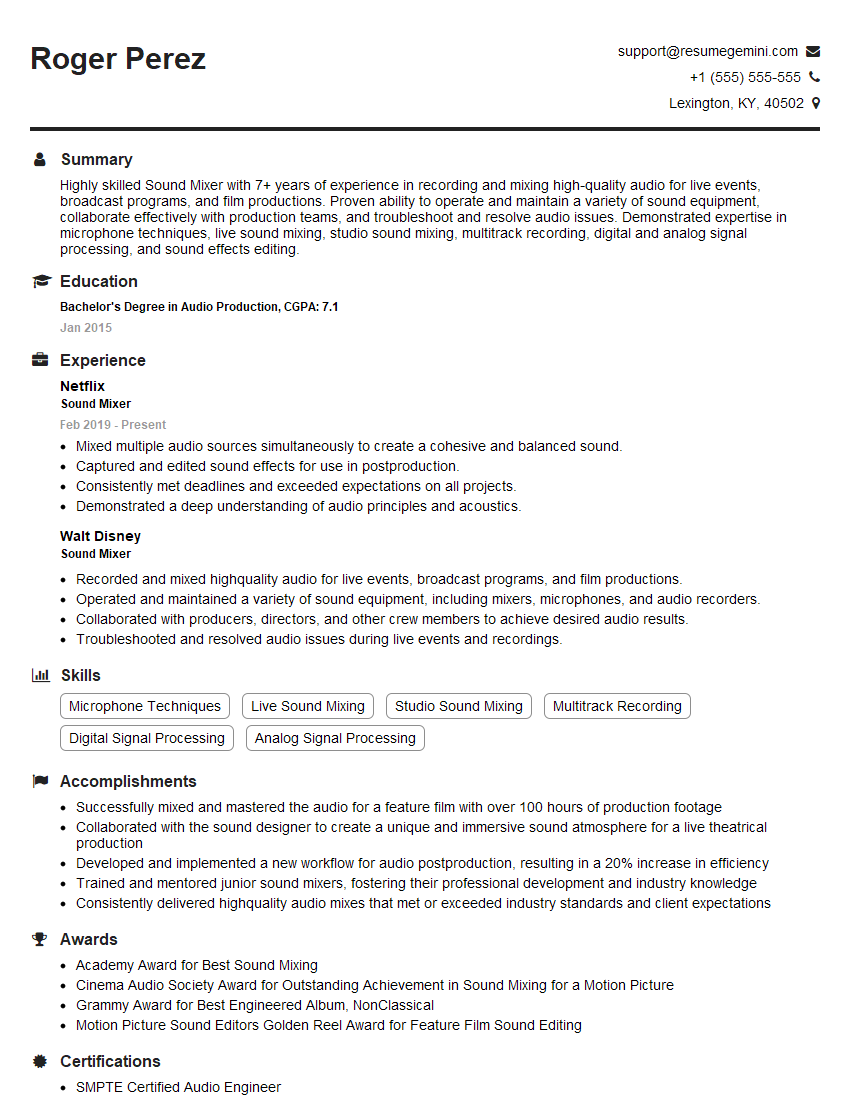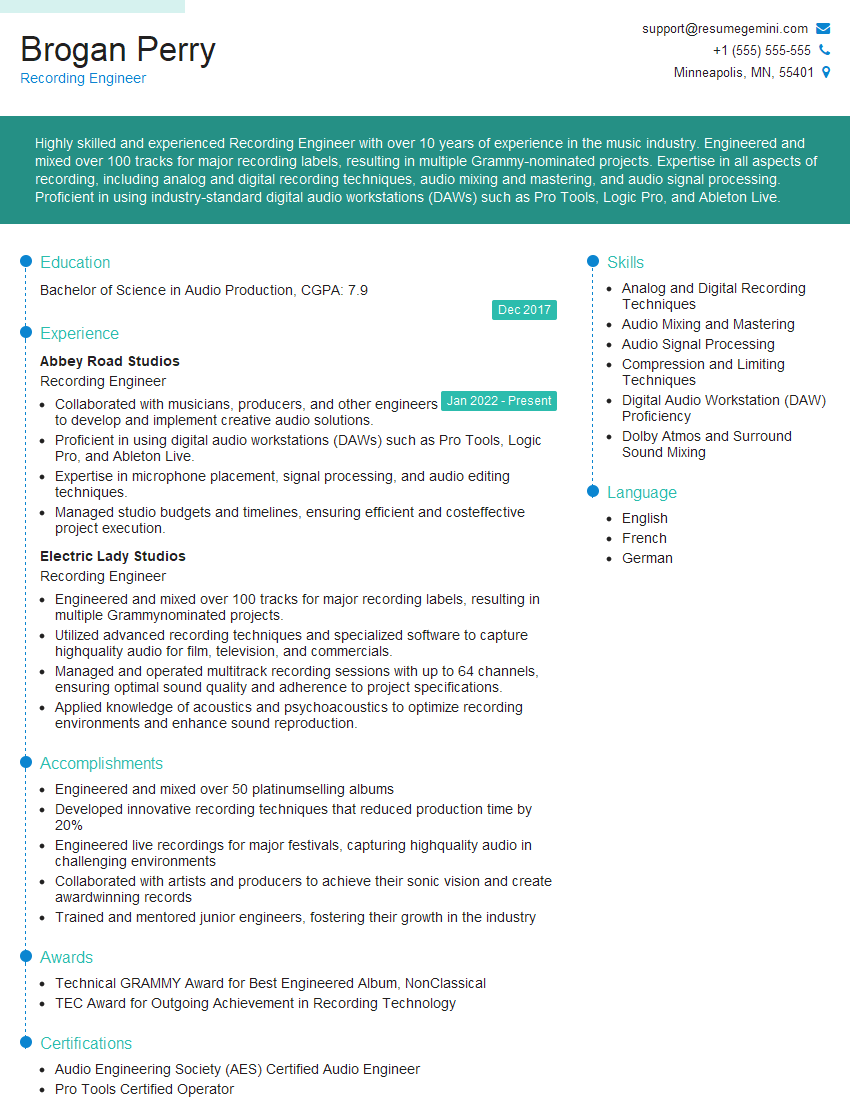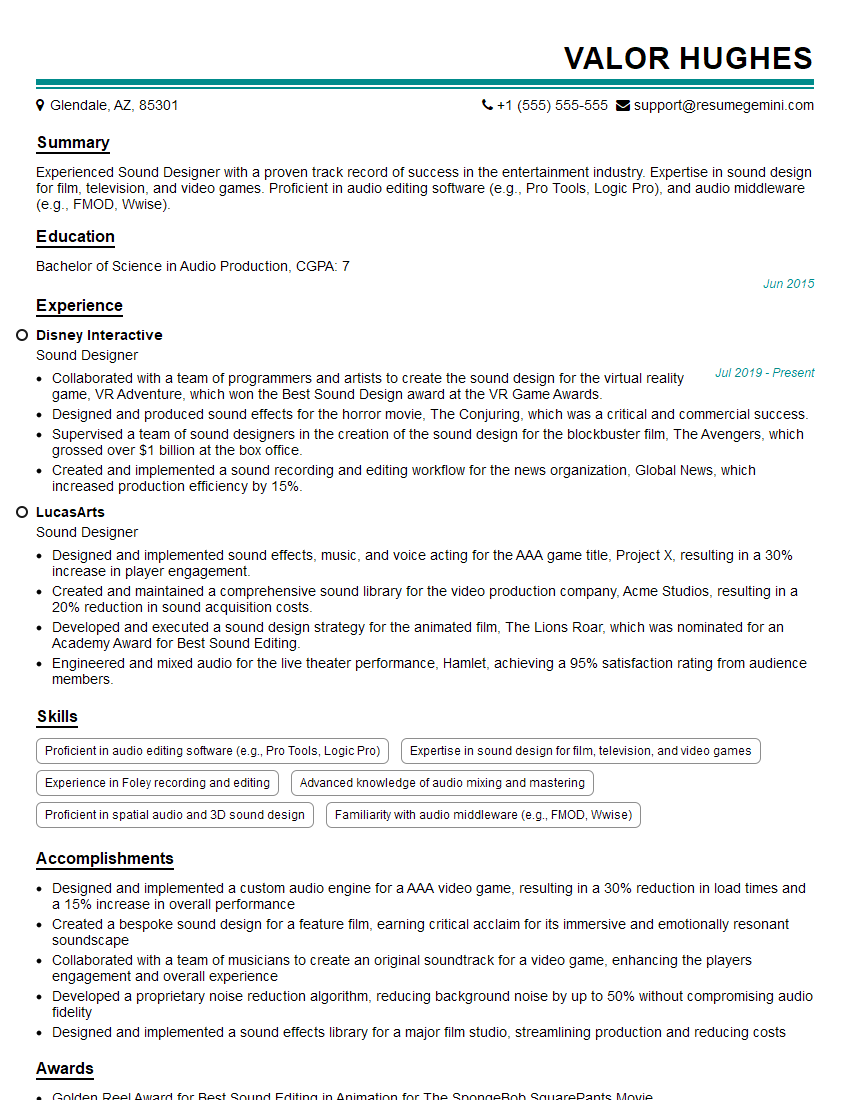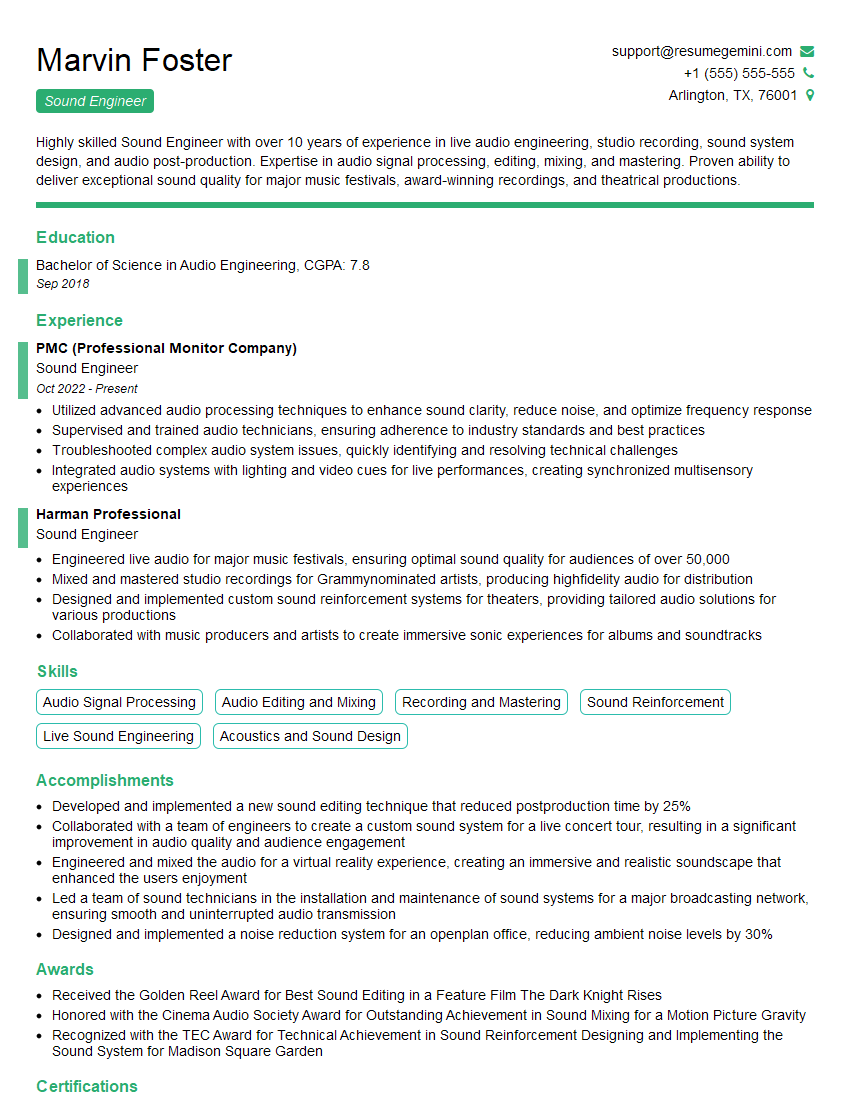The thought of an interview can be nerve-wracking, but the right preparation can make all the difference. Explore this comprehensive guide to Sound Equipment Setup and Operation interview questions and gain the confidence you need to showcase your abilities and secure the role.
Questions Asked in Sound Equipment Setup and Operation Interview
Q 1. Explain the difference between condenser and dynamic microphones.
Condenser and dynamic microphones are the two primary types of microphones, differing fundamentally in how they convert sound waves into electrical signals. Think of it like this: a condenser mic is like a highly sensitive electronic ear, while a dynamic mic is a more robust, less sensitive one.
- Condenser Microphones: These use a capacitor – two electrically charged plates – to convert sound waves. Sound vibrations cause the distance between these plates to change, altering the capacitance and generating an electrical signal. They’re known for their sensitivity, capturing subtle nuances and high frequencies exceptionally well. This makes them ideal for recording delicate instruments like acoustic guitars or vocals requiring a detailed sound. However, they require phantom power (48V DC) supplied by a mixing console or audio interface.
- Dynamic Microphones: These utilize a moving coil within a magnetic field. Sound waves cause the coil to move, inducing an electrical current. They are less sensitive than condensers, but significantly more rugged and less susceptible to damage from high sound pressure levels (SPL). This makes them perfect for live performances, particularly with loud instruments like drums or amplified guitars. They don’t require phantom power.
In short: Condenser mics are sensitive and detailed, great for studio recording, while dynamic mics are robust and handle high SPLs, ideal for live sound.
Q 2. Describe the process of setting up a PA system for a small concert.
Setting up a PA system for a small concert involves careful planning and execution. Here’s a step-by-step process:
- Assess the Venue: Determine the size of the space, its acoustics (reverberation, reflections), and the anticipated audience size. This informs your speaker choices and placement.
- Choose the Right Equipment: Select appropriate mixers, amplifiers, speakers (PA speakers, monitors), microphones (depending on the instruments and vocals), and cables. For a small concert, a compact mixer with enough channels for all your inputs is crucial.
- Speaker Placement: Position main PA speakers at an angle towards the audience, ideally elevated to ensure even sound coverage. Monitor speakers should be placed on stage, close enough to the performers for adequate feedback.
- Microphone Placement: Carefully position microphones to minimize feedback and maximize signal quality. Consider using different microphone types for various instruments; for example, a condenser mic for acoustic guitar, a dynamic mic for vocals.
- Mixing and Sound Check: Connect all equipment correctly, adjusting levels (gain) carefully. A sound check is absolutely essential to balance instrument and vocal levels, reduce feedback, and ensure optimal sound quality before the concert begins. Remember the ‘rule of thumb’ for sound check: check the levels at the furthest point from the speakers.
- Cable Management: Neatly organize cables to prevent tripping hazards and improve stage aesthetics. Use cable ties or wraps to keep things tidy.
Remember to always prioritize safety. Ensure all equipment is properly grounded and that all connections are secure.
Q 3. How do you troubleshoot feedback in a sound system?
Feedback, that ear-piercing squeal, occurs when sound from the speakers is picked up by a microphone, amplified, and sent back through the system, creating a continuous loop. Troubleshooting involves systematically identifying and addressing the problem’s source.
- Identify the Frequency: Pinpoint the specific frequency causing the feedback. A graphic equalizer can help isolate the offending frequencies.
- Reduce Microphone Gain: Lowering the input gain on the microphone channel reduces the signal going into the mixer, lessening the likelihood of feedback.
- Adjust Equalizer Settings: Use a parametric equalizer to cut the feedback frequency. Slightly reducing the gain in the feedback frequency range can often eliminate the issue without affecting the overall sound quality significantly.
- Microphone Placement: Reposition the microphone to minimize its pickup of sound from the speakers. This might involve moving the mic further away from the speakers or angling it differently. Point the microphone away from the speakers.
- Speaker Placement: Adjust speaker positioning to reduce the amount of sound reaching the microphones. Directing the speakers away from the microphones is essential.
- Use Feedback Reduction Devices: Consider using feedback suppressors or noise gates, which are designed to automatically reduce or eliminate feedback.
The key is to be methodical. Try one adjustment at a time, listening carefully to see if the feedback is reduced or eliminated. If not, try the next step in the process.
Q 4. What are the different types of audio cables and their applications?
Various audio cables serve distinct purposes, each designed for specific signal types and applications:
- XLR Cables: These are three-pin connectors commonly used for professional microphones and line-level audio signals. They are balanced, meaning they are less susceptible to noise interference, making them ideal for long cable runs. They are often used with dynamic and condenser microphones.
- 1/4-inch (6.35mm) TS Cables (Tip-Sleeve): These are unbalanced cables with two conductors. They’re commonly used for instruments like guitars, basses, and keyboards. Commonly used with instruments and line-level devices.
- 1/4-inch (6.35mm) TRS Cables (Tip-Ring-Sleeve): These are balanced cables with three conductors. They are used for stereo signals or balanced line-level audio. It’s vital to know the difference between TS and TRS.
- RCA Cables: These are unbalanced cables with two conductors, typically used for consumer-level audio, such as connecting CD players to home stereo systems. RCA cables are not recommended for professional use due to their susceptibility to noise.
- USB Cables: These are used to transfer digital audio signals between devices like audio interfaces and computers. Used for DAWs (Digital Audio Workstations).
- Digital Audio Cables (ADAT, AES/EBU, S/PDIF): These are used to transmit high-quality digital audio signals between devices. They offer higher quality compared to analog cables and are widely used in professional settings. These include ADAT, AES/EBU, and S/PDIF.
The right cable choice is critical for ensuring signal quality and minimizing noise. Choosing the wrong cable can lead to signal loss, unwanted noise, and even damage to equipment.
Q 5. Explain the concept of impedance matching.
Impedance matching is the process of ensuring that the output impedance of an audio device (e.g., a microphone or amplifier) is compatible with the input impedance of the next device in the signal chain (e.g., a mixing console or speaker). Think of it as a smooth transfer of energy from one component to the next.
When impedance is mismatched, it can lead to signal loss (low impedance into high impedance) or signal reflection (high impedance into low impedance), resulting in a weaker or distorted sound. The ideal scenario is to have a low output impedance from a device and a high input impedance in the receiving device. This prevents signal loss.
For example, a microphone with a low output impedance (typically 150-600 ohms) should be connected to a mixer with a much higher input impedance (typically 1k-10k ohms or greater). This minimizes signal loss and ensures a strong, clear signal.
Mismatch can cause issues with audio levels and signal quality. Proper impedance matching ensures efficient signal transfer and prevents signal degradation, particularly crucial in long audio runs.
Q 6. How do you choose the right microphone for a specific instrument or vocal?
Choosing the right microphone for a specific instrument or vocal depends on several factors, including the instrument’s acoustic properties and the desired sonic characteristics.
- Vocals: For vocals, cardioid dynamic microphones are popular for live performances due to their robustness and feedback rejection. Condenser microphones are often preferred for studio recordings, capturing detail and nuances in the vocal performance.
- Acoustic Guitar: Large-diaphragm condenser microphones are often used to capture the subtle details of an acoustic guitar’s sound. A small-diaphragm condenser can be suitable for a more focused, detailed sound.
- Electric Guitar: Dynamic microphones are typically used for electric guitars, capturing the raw power and punch of the amplified sound. Different microphone positions along the speaker can yield various tonal characteristics.
- Drums: A variety of microphones are typically used for drums – dynamic mics for snare and toms, condenser mics for overheads and hi-hats. The choice of microphone affects the sound significantly.
- Brass Instruments: Dynamic mics are commonly employed for brass instruments to handle high sound levels. They must be able to handle the high volume and dynamic range.
Factors to consider include the microphone’s polar pattern (cardioid, omnidirectional, figure-8), frequency response, and sensitivity. Experimentation is key. Trying different microphone types and placements helps to achieve the desired sound for each instrument.
Q 7. Describe your experience with digital audio workstations (DAWs).
I have extensive experience working with various Digital Audio Workstations (DAWs), including Pro Tools, Logic Pro X, Ableton Live, and Cubase. My experience encompasses a wide range of tasks, from basic recording and editing to advanced mixing, mastering, and sound design.
I’m proficient in using DAWs to record and edit audio, utilizing various plugins for effects processing, including EQ, compression, reverb, delay, and more. I’m also comfortable working with MIDI data, creating and editing MIDI sequences, and integrating virtual instruments into my projects. I have utilized DAWs for both studio recording and post-production sound for various projects, including music production, film scoring, and podcast editing.
My expertise extends to troubleshooting common DAW issues, optimizing recording settings for various audio sources, and managing large audio projects efficiently. I’m familiar with various audio file formats and standards, and I know how to export and share my work in various formats.
I have a firm grasp of signal flow within a DAW, understanding how different plugins and effects interact. I’ve used my knowledge to achieve high-quality audio across diverse projects and sound requirements. My DAW skills constantly evolve as I adapt to new technologies and methodologies.
Q 8. How do you manage multiple audio sources on a mixing console?
Managing multiple audio sources on a mixing console is all about organization and prioritization. Think of it like conducting an orchestra – each instrument (audio source) needs its own space and volume, but they all work together to create a harmonious whole. We typically use different channels on the console for each source. Each channel allows for independent control of volume, EQ, and effects.
For example, imagine a live band setup. We might have a channel for each instrument (drums, bass, guitars, vocals) and possibly a channel for backing tracks or other audio effects. Each channel receives a signal from its respective microphone or instrument input. On the console, we can adjust the individual levels of each channel, ensuring a balanced mix.
Advanced techniques include using subgroups and aux sends to create more control and flexibility. Subgroups allow you to group related channels (e.g., all the drums) for easier level adjustments. Aux sends route a signal to external effects processors or monitor mixes.
Q 9. Explain the function of EQ, compression, and gating.
EQ (Equalization), compression, and gating are fundamental audio processing tools that shape the sound and manage dynamics. Let’s break them down:
- EQ: EQ allows us to adjust the frequency balance of a signal. Imagine a sound as a collection of different colored lights; EQ lets us brighten or dim specific colors (frequencies). We use it to boost or cut certain frequencies to enhance clarity, remove muddiness, or shape the overall tone. For instance, boosting the high frequencies on a vocal makes it more crisp, while cutting the low frequencies on a bass guitar prevents it from sounding too muddy.
- Compression: Compression reduces the dynamic range of a signal. Think of it as a smoothing tool; it controls the difference between the loudest and quietest parts of a sound. It’s invaluable for bringing out quieter details in a recording without the loud parts overwhelming everything else. For example, a heavily compressed drum track will have consistent volume even during rapid changes in dynamics.
- Gating: Gating reduces or eliminates signals below a certain threshold. Imagine a gate as a filter that only lets audio through above a chosen noise level; this is particularly useful for removing unwanted background noise or ambience between notes in a recording. For example, you can use a gate to reduce the hiss between guitar chords.
Q 10. What is phantom power and how does it work?
Phantom power is a convenient way to supply power to condenser microphones without needing separate power cables. Many condenser mics require external power to operate their internal electronics. Phantom power is a 48-volt DC voltage supplied through the XLR microphone cable. It’s ‘phantom’ because the power is superimposed on the audio signal and doesn’t interfere with it. Most mixing consoles and audio interfaces have a switch to enable or disable phantom power on individual channels.
How it Works: The phantom power is applied equally to pins 2 and 3 of the XLR connector, while pin 1 is ground. The microphone’s internal circuitry is designed to tap into this power without affecting the audio signal path. It’s crucial to remember that not all microphones are compatible with phantom power – using phantom power with a dynamic microphone can damage it.
Q 11. How do you set up and monitor speaker levels?
Setting up and monitoring speaker levels is critical for a safe and enjoyable listening experience. We start by setting the overall system gain structure, which ensures enough signal to the speakers without clipping (distortion). We usually use a sound level meter (SLM) or a digital audio workstation (DAW) with metering capabilities to measure the sound pressure level (SPL).
Step-by-Step:
- Start with a low volume on all devices.
- Input each source at a safe level and gradually increase the levels.
- Monitor the output levels on the mixing console or DAW, making sure the levels do not exceed 0dBFS (digital clipping point) or cause distortion in the speakers.
- Using the SLM, measure the peak SPL in the listening area to ensure it stays within safe levels for both the audience and equipment.
- Adjust gain throughout the system to fine-tune the output levels.
Regular monitoring is key; using level indicators on our mixing console or DAW is essential for real-time awareness of levels. This helps avoid damaging speakers from excessive power, clipping and feedback issues that can be harmful to our ears. Different environments will require different levels, which need monitoring throughout the event.
Q 12. Describe your experience with different types of audio processors.
My experience encompasses a wide range of audio processors, including:
- Equalizers (EQ): Graphic EQs, parametric EQs, and dynamic EQs. I’ve worked with both hardware and software versions, understanding the nuances of shaping frequencies for various instruments and vocals.
- Compressors: Optical, FET, VCA compressors and multiband compressors, each with their distinct character and applications. I am skilled at using compression for shaping dynamics, controlling volume levels, and adding punch and impact to audio signals.
- Gate/Expanders: Used to control background noise and unwanted sounds, creating a cleaner signal. I have experience selecting and using gates to eliminate noise between musical phrases.
- Reverb and Delay Processors: Creating natural or artificial ambience to enhance the audio. I understand various reverb algorithms and delay time settings.
- Digital Signal Processors (DSP): I am familiar with integrating DSP units into my workflows and working with various plug-ins in DAWs for different signal processing needs.
I understand the strengths and weaknesses of different processors and choose the appropriate tools based on the specific needs of the project and environment.
Q 13. What are your strategies for managing sound levels in various environments?
Managing sound levels effectively in various environments requires adaptability and careful planning. I always begin by assessing the acoustics of the space. Small, reverberant rooms require different approaches compared to large, open spaces. For example, a small room might benefit from using absorption panels to minimize reflections and reduce excess reverberation while a large space might require more powerful amplification systems to provide adequate coverage and volume.
Strategies:
- Sound Level Meter (SLM) Usage: Consistent use of an SLM to measure and monitor sound pressure levels is key.
- Room EQ: Acoustic treatment and/or digital room correction software can greatly improve the sound quality and evenness of levels.
- Gain Staging: Setting appropriate levels throughout the signal chain from input to output prevents clipping or distortion.
- Feedback Control: Employing techniques like EQ notch filters, strategically placing microphones, and monitoring speaker placement effectively minimizes feedback issues.
- Audience Considerations: Understanding the requirements for audience size and type helps me appropriately set sound levels.
Q 14. How do you perform preventative maintenance on sound equipment?
Preventative maintenance is crucial for ensuring reliable sound equipment. My approach involves a combination of regular inspections, cleaning, and testing.
My routine typically includes:
- Visual Inspection: Regularly checking cables for damage, loose connections, and wear and tear.
- Cleaning: Dusting and cleaning components such as mixing consoles, speakers, and microphones to prevent overheating and malfunctions.
- Testing: Periodically testing all equipment and connections to confirm functionality.
- Documentation: Maintaining accurate records of maintenance performed helps identify patterns or potential issues.
- Professional Service: Scheduling professional service and calibrations to ensure optimal performance and prevent unexpected equipment failure.
Preventative maintenance not only extends the life of the equipment but also minimizes unexpected downtime and avoids expensive repairs, and above all, ensures the quality of the audio output.
Q 15. Explain your experience with wireless microphone systems.
Wireless microphone systems are essential for many sound applications, offering freedom of movement for performers. My experience encompasses various systems, from basic UHF systems to more sophisticated digital wireless microphones with features like frequency hopping and AES-256 encryption. I’m proficient in selecting the appropriate system based on factors such as range, interference susceptibility, number of channels required, and budget constraints. For instance, in a large outdoor event prone to RF interference, I’d choose a digital system with frequency hopping to ensure signal stability. In a smaller, controlled environment like a conference room, a more affordable UHF system might suffice. I’m also experienced in troubleshooting common issues like dropouts, interference, and low signal strength, often using spectrum analyzers to identify and resolve frequency conflicts.
I’ve worked with brands like Shure, Sennheiser, and AKG, familiar with their respective strengths and weaknesses. My experience also covers installation and configuration of antenna systems, which are crucial for optimal wireless microphone performance. Proper antenna placement and aiming significantly improve signal quality and reduce dropouts.
Career Expert Tips:
- Ace those interviews! Prepare effectively by reviewing the Top 50 Most Common Interview Questions on ResumeGemini.
- Navigate your job search with confidence! Explore a wide range of Career Tips on ResumeGemini. Learn about common challenges and recommendations to overcome them.
- Craft the perfect resume! Master the Art of Resume Writing with ResumeGemini’s guide. Showcase your unique qualifications and achievements effectively.
- Don’t miss out on holiday savings! Build your dream resume with ResumeGemini’s ATS optimized templates.
Q 16. What is your approach to troubleshooting a malfunctioning audio component?
My approach to troubleshooting a malfunctioning audio component is systematic and follows a logical process. I start by identifying the problem precisely; is it no sound, distorted sound, feedback, or something else? I then isolate the component – is it the microphone, mixer, amplifier, or speakers? A simple visual inspection often reveals loose connections or obvious damage. Next, I use signal tracing techniques to pinpoint where the problem lies in the signal chain. This might involve using a multimeter to check for power, signal continuity, and proper impedance matching.
If a specific component is suspected, I might swap it out with a known working component to isolate the faulty piece. I document every step of the troubleshooting process, which is extremely valuable for future reference. For instance, during a recent concert, a monitor speaker suddenly cut out. By systematically checking the connections, power supply, and the speaker itself, I discovered a blown fuse, which was easily replaced, restoring the sound.
Q 17. How do you ensure proper signal flow in a complex audio setup?
Ensuring proper signal flow in a complex audio setup is crucial for a quality output. I utilize a clear understanding of the signal path, from input to output, which involves carefully planning the routing of audio signals through mixers, processors, and amplifiers. I use signal flow diagrams to visually represent the entire system, which aids in identifying potential problems and simplifying troubleshooting. This is much like a blueprint for your sound system.
Each component has its specific input and output levels and impedances. Mismatches can lead to signal loss or distortion. I carefully match these parameters to optimize the signal path and to avoid signal degradation. For example, using a line-level signal at a microphone-level input will result in very low output volume. Using appropriate signal converters or attenuators will remedy this. I also carefully manage gain staging across the entire system to prevent clipping (distortion caused by signal overload). By strategically setting levels at each stage, I create a balanced signal across the system.
Q 18. What software and hardware are you familiar with?
My experience spans a wide range of audio software and hardware. In software, I’m proficient in Digital Audio Workstations (DAWs) such as Pro Tools, Logic Pro X, and Ableton Live. These are crucial for recording, editing, and mixing audio. I’m also adept at using room acoustic simulation software like EASE to optimize speaker placement and sound quality in various venues.
Regarding hardware, I’m highly familiar with mixing consoles from brands like Yamaha, Soundcraft, and Allen & Heath, as well as various microphone preamps, compressors, equalizers, and effects processors. I understand the intricacies of different audio interfaces, including their sample rates, bit depths, and latency characteristics, choosing the best one for each project’s needs. For instance, I might use a high-end interface with low latency for live recording, while a more affordable option might be suitable for a basic podcast setup.
Q 19. Describe your experience with sound system design and planning.
Sound system design and planning involve understanding the acoustic properties of the space, the intended use, and the audience. I start by assessing the venue’s acoustics, including its size, shape, and reverberation characteristics. Then, I determine the desired sound coverage, taking into account factors such as audience size, speaker placement, and potential sound reflections. I carefully select speakers appropriate for the venue and the type of event. Smaller speakers for intimate settings versus larger, more powerful speakers for large concert halls or outdoor events.
I utilize acoustical modeling software and my own experience to optimize speaker placement, minimizing unwanted reflections and maximizing even sound distribution throughout the space. My designs also incorporate considerations for microphone placement, ensuring optimal signal capture with minimal feedback. A successful design ensures clear, even sound for everyone in the audience, whether at the front or the back.
Q 20. How do you handle time constraints and pressure during live events?
Handling time constraints and pressure during live events requires a combination of preparation, organization, and efficient problem-solving. Prior to the event, I create detailed checklists for setup, sound checks, and troubleshooting procedures. I thoroughly test all equipment beforehand to minimize potential delays during the event. Having a well-defined plan and a team you can rely on is paramount.
During the event, my focus is on prioritizing tasks and efficiently addressing any issues that arise. Effective communication with the event team is critical in ensuring everyone is aware of potential issues and solutions. I remain calm under pressure and effectively delegate tasks as needed. In high-pressure situations, my experience enables me to make quick decisions and prioritize resolving critical issues, ensuring a smooth and successful event. Prioritizing tasks based on impact allows for a controlled approach to solve problems while managing the pressure.
Q 21. Explain your understanding of acoustic treatment in different spaces.
Acoustic treatment is crucial for controlling sound reflections and reverberation in different spaces. My understanding of this involves knowing how different materials absorb, reflect, and diffuse sound. In a recording studio, for instance, the goal is to minimize unwanted reflections by using acoustic panels and bass traps to achieve a dry, controlled sound. This ensures high-fidelity recordings.
In a live performance venue, the approach may differ. Some reverberation is often desirable to enhance the ambience, but excessive reverberation can cause muddiness and loss of clarity. In these situations, I might use diffusers to scatter sound reflections more evenly, reducing harsh reflections while retaining some natural ambience. The approach always depends on the room and its function. In smaller spaces, careful treatment of the walls, floor, and ceiling might eliminate unwanted resonances and improve overall sound quality. Larger spaces might need more extensive treatments with strategically placed absorbers and diffusers to shape the overall acoustics.
Q 22. Describe your experience with setting up monitoring systems for musicians.
Setting up a monitoring system for musicians requires a deep understanding of their needs and the acoustic environment. It’s not just about providing sound; it’s about creating a comfortable and effective listening experience that allows them to perform at their best. I begin by consulting with the musicians to understand their individual preferences, the genre of music, and the complexity of their arrangements. This helps determine the type of monitors needed – nearfield monitors for close listening, or larger monitors for a more spacious sound.
For example, a jazz quartet might require accurate reproduction of subtle nuances, opting for studio-quality nearfield monitors. A rock band, however, might benefit from more powerful monitors capable of handling higher volumes. Next, I consider the acoustic treatment of the room. This includes assessing the room’s natural reverb and using acoustic panels to minimize reflections and standing waves, which can muddy the sound. Careful placement of monitors is crucial to avoid comb filtering (destructive interference caused by overlapping sound waves) and to ensure a balanced listening experience for each musician. I typically use a combination of A/B testing and frequency response analysis tools to fine-tune the position and levels. Finally, I provide clear instructions to the musicians on how to adjust their individual monitor levels for optimal listening.
Q 23. How do you calibrate a sound system for optimal audio quality?
Calibrating a sound system is a multi-step process crucial for achieving optimal audio quality. It involves using specialized equipment and techniques to ensure accurate frequency response, consistent levels across all speakers, and minimal distortion. The process typically starts with acoustic treatment, as mentioned earlier, to control the room’s acoustics. Next, I use a calibrated measurement microphone and software such as Smaart or Room EQ Wizard (REW) to measure the system’s frequency response at various points in the listening area. This reveals any peaks or dips in the frequency range which can be addressed through equalization (EQ).
For example, if there’s a significant boost in the low frequencies (bass), it can be reduced using a parametric equalizer to avoid a muddy sound. Similarly, if there’s a lack of high frequencies (treble), it can be subtly boosted to provide clarity. Once the EQ is adjusted, the overall system levels are balanced, ensuring that each speaker outputs the correct volume and that the system does not overload. This is done using a sound level meter (SLM) to measure the sound pressure level (SPL) at various listening positions. Then, delay alignment might be needed to correct for time discrepancies between different speakers, particularly in larger systems. The final step involves checking for distortion and ensuring all connections are stable. A thorough calibration ensures a flat, accurate frequency response, providing a clear and natural sound reproduction.
Q 24. What are your strategies for dealing with difficult performers?
Dealing with difficult performers requires a combination of diplomacy, technical expertise, and a calm demeanor. Understanding their needs and motivations is key. For example, a performer might be frustrated by a technical issue, leading to aggressive behavior. In such cases, I address the technical problem efficiently while maintaining a professional and respectful attitude. I avoid getting into arguments and instead focus on solutions. Open communication is crucial. I explain my technical decisions clearly and listen to their concerns. Sometimes, a simple adjustment to their monitor mix or microphone position can make a significant difference. If their issue stems from personal frustration or stress, a calm and reassuring approach is necessary. Offering them support and understanding can often de-escalate the situation. I also ensure a clear chain of command— if I am unable to address the situation, I escalate it to the appropriate personnel.
In extreme cases where behavior becomes disruptive or abusive, I would involve the event management or security team to ensure the safety and well-being of everyone involved. It’s always about finding a balance between accommodating the performer’s needs while maintaining a professional and controlled environment for the audience and the rest of the production team.
Q 25. Explain your experience working with different types of mixing consoles.
My experience encompasses a wide range of mixing consoles, from small analog mixers like the Allen & Heath ZED series to large digital consoles such as the Yamaha RIVAGE PM10 and Avid S6. Each console has its own strengths and weaknesses, and my approach adapts accordingly. Analog consoles offer a direct and tactile feel, allowing for intuitive adjustments to gain, EQ, and dynamics. They are often preferred for their warm sound and simplicity in smaller-scale applications. Digital consoles, on the other hand, provide greater flexibility and recall capabilities. They allow for detailed automation, sophisticated signal processing, and the storage of entire show setups. They are ideal for large-scale productions and complex setups.
For instance, I might use a compact analog mixer for a small acoustic performance, prioritizing its ease of use and warm sound. However, for a large festival with multiple inputs and extensive automation requirements, a large-format digital console would be essential. Regardless of the console type, my core approach remains consistent: Understanding the signal flow, accurately routing the signals, achieving a balanced mix, and ensuring appropriate levels are key aspects of my workflow. I always prioritize a clear and organized approach to signal routing, regardless of the console’s complexity.
Q 26. How do you ensure audio clarity and balance in a live performance?
Ensuring audio clarity and balance in a live performance is a critical aspect of sound engineering. It involves a combination of pre-show preparation, precise mixing during the performance, and effective communication with the performers. Before the show, I meticulously check all equipment, conduct sound checks with each musician to optimize their individual levels and instrument tones, and set up the PA system for appropriate coverage of the venue. During the performance, active listening is paramount. I constantly monitor the overall balance, adjusting levels as needed to ensure that all instruments and vocals are clearly audible and well-integrated.
For example, I might need to boost the vocals slightly during a quieter section of a song or reduce the bass levels to prevent muddiness when several instruments are playing together. Effective EQ is also crucial, as mentioned earlier, to address any frequency imbalances or resonances. Compression can help control dynamic range, making the sound more consistent and less prone to peaks. Furthermore, I use a combination of visual cues (watching the VU meters) and auditory cues (listening for any problems) to adjust the mix in real-time. Lastly, clear communication with the performers allows me to anticipate any changes and adjust the mix accordingly, optimizing the overall listening experience for the audience.
Q 27. Describe your experience with audio recording techniques.
My experience in audio recording techniques spans a variety of genres and settings. I’m proficient in both analog and digital recording techniques, using a range of microphones, pre-amplifiers, and recording software. My approach emphasizes capturing the natural sound of an instrument or voice while also using techniques to shape and enhance the recording. This includes understanding microphone placement techniques for different instruments, choosing appropriate pre-amps to match the microphone and the source, and utilizing effective EQ and compression to refine the sound. I’m also skilled in multi-track recording, allowing for flexibility in editing, mixing, and mastering. Furthermore, I utilize phase alignment techniques to prevent unwanted cancellations, and address any room acoustics issues through techniques like gated reverb or microphone placement to minimize unwanted ambient sound.
For example, when recording vocals, I might use a large-diaphragm condenser microphone to capture warmth and detail, placing it a few inches from the vocalist’s mouth for a clear and intimate sound. Conversely, for acoustic instruments, I might use a more directional microphone to isolate the source and minimize room ambience. Post-recording, I meticulously edit, mix, and master the recordings, paying close attention to details like timing, balance, and overall clarity. The goal is to create a final product that accurately represents the performance and meets the client’s expectations. I consistently use digital audio workstations (DAWs) like Pro Tools or Logic Pro X for my editing and mixing workflows.
Key Topics to Learn for Sound Equipment Setup and Operation Interview
- Microphone Techniques: Understanding different microphone types (dynamic, condenser, ribbon), polar patterns (cardioid, omnidirectional, figure-8), placement techniques for optimal sound capture, and troubleshooting common microphone issues.
- Mixing Console Operation: Familiarization with various mixing consoles, including their functionalities (gain staging, equalization, dynamics processing, aux sends/returns), signal flow understanding, and practical application in live sound reinforcement or studio recording.
- Speaker Systems and PA Setup: Knowledge of different speaker types (passive, active), speaker placement strategies for even sound coverage, impedance matching, and understanding power requirements and limitations. Troubleshooting PA system problems like feedback and distortion.
- Audio Signal Processing: Understanding basic signal processing concepts like equalization (EQ), compression, limiting, and reverb, and their practical applications in shaping sound and improving audio quality.
- Digital Audio Workstations (DAWs): Familiarity with common DAW software (Pro Tools, Logic Pro, Ableton Live, etc.) for recording, editing, and mixing audio. This includes understanding track management, routing, and basic mixing techniques.
- Troubleshooting and Problem-Solving: Developing a systematic approach to identify and resolve technical issues during setup and operation. This includes recognizing symptoms, identifying potential causes, and implementing solutions efficiently.
- Health and Safety: Understanding safe working practices related to sound equipment, including proper handling, grounding, and risk mitigation strategies.
- Audio Cables and Connections: Understanding different cable types (XLR, TRS, RCA), their applications, and proper connection techniques to avoid signal loss or interference.
Next Steps
Mastering Sound Equipment Setup and Operation opens doors to exciting career opportunities in live sound, studio recording, broadcast, and more. A strong foundation in these skills significantly increases your employability and potential for career growth. To stand out, create a compelling and ATS-friendly resume that highlights your skills and experience effectively. ResumeGemini is a trusted resource that can help you build a professional resume tailored to your specific skills and experience. Examples of resumes tailored to Sound Equipment Setup and Operation are available to help you create the perfect application.
Explore more articles
Users Rating of Our Blogs
Share Your Experience
We value your feedback! Please rate our content and share your thoughts (optional).
What Readers Say About Our Blog
Hello,
We found issues with your domain’s email setup that may be sending your messages to spam or blocking them completely. InboxShield Mini shows you how to fix it in minutes — no tech skills required.
Scan your domain now for details: https://inboxshield-mini.com/
— Adam @ InboxShield Mini
Reply STOP to unsubscribe
Hi, are you owner of interviewgemini.com? What if I told you I could help you find extra time in your schedule, reconnect with leads you didn’t even realize you missed, and bring in more “I want to work with you” conversations, without increasing your ad spend or hiring a full-time employee?
All with a flexible, budget-friendly service that could easily pay for itself. Sounds good?
Would it be nice to jump on a quick 10-minute call so I can show you exactly how we make this work?
Best,
Hapei
Marketing Director
Hey, I know you’re the owner of interviewgemini.com. I’ll be quick.
Fundraising for your business is tough and time-consuming. We make it easier by guaranteeing two private investor meetings each month, for six months. No demos, no pitch events – just direct introductions to active investors matched to your startup.
If youR17;re raising, this could help you build real momentum. Want me to send more info?
Hi, I represent an SEO company that specialises in getting you AI citations and higher rankings on Google. I’d like to offer you a 100% free SEO audit for your website. Would you be interested?
Hi, I represent an SEO company that specialises in getting you AI citations and higher rankings on Google. I’d like to offer you a 100% free SEO audit for your website. Would you be interested?
good
